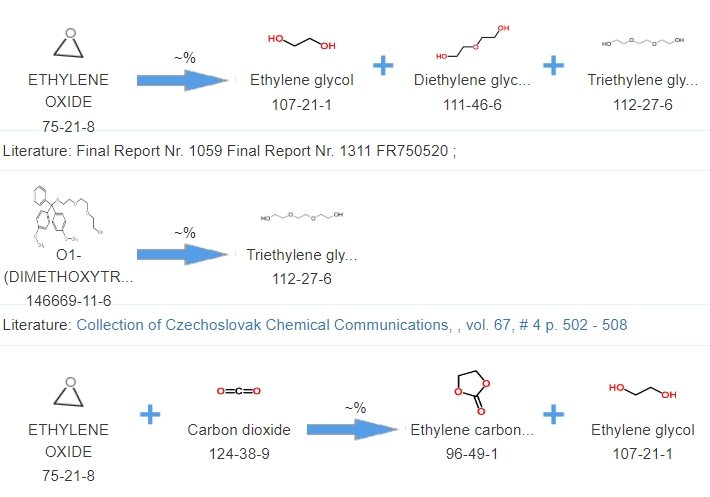What is triethylene glycol used for?
Triethylene glycol (TEG) has several
important uses across various industries:
Natural Gas Dehydration: TEG is commonly employed as a desiccant in the natural gas industry to remove water
from natural gas streams. It prevents the formation of hydrates, which can obstruct pipelines and equipment,
by absorbing moisture from the gas.
Solvent: TEG serves as a versatile solvent in industries such as pharmaceuticals, textiles, and cosmetics. It
is used for dissolving various substances, including dyes, resins, and cellulose derivatives.
Plasticizers: TEG can be utilized as a plasticizer in the production of plastics, improving their flexibility
and durability.
Humectant: In personal care products like skincare items and cosmetics, TEG functions as a humectant, helping
to retain moisture and prevent dryness.
Chemical Intermediates: TEG is also employed in the synthesis of other chemicals, such as surfactants and
lubricants.
Overall, triethylene glycol plays a crucial role in multiple industrial processes due to its properties as a
solvent, desiccant, plasticizer, and humectant.
Does triethylene glycol kill viruses?
Triethylene glycol (TEG) is known for its ability to disrupt the structure of viruses and bacteria, thereby
potentially inhibiting their growth or killing them. However, the effectiveness of TEG against specific
viruses can vary depending on factors such as the concentration of TEG, the type of virus, and the conditions
of exposure.
TEG is sometimes used as an ingredient in disinfectants and sanitizers due to its antimicrobial properties.
However, its effectiveness against viruses may not be as high as other disinfectants specifically formulated
for virus eradication.
It's essential to use TEG and products containing TEG according to manufacturer instructions and to adhere to
recommended disinfection practices, especially when targeting viruses. Additionally, consulting with
healthcare professionals or experts in virology can provide more accurate information on the efficacy of TEG
against specific viruses.
Is triethylene glycol safe for skin?
Triethylene glycol (TEG) is generally considered safe for skin when used in concentrations deemed safe for
cosmetic and personal care products. It is often used as a humectant in skincare products, such as
moisturizers and creams, to help retain moisture and improve skin hydration.
However, like any ingredient, TEG may cause skin irritation or allergic reactions in some individuals,
particularly those with sensitive skin. It's essential to perform a patch test before using products
containing TEG, especially if you have known sensitivities or allergies to skincare ingredients.
Additionally, using TEG-containing products according to manufacturer instructions and avoiding prolonged or
excessive exposure can help minimize the risk of adverse reactions. If you experience any skin irritation or
discomfort after using products containing TEG, it's advisable to discontinue use and consult a dermatologist.
Why is triethylene glycol used as a solvent?
Versatility: TEG has a high solvency power, meaning it can dissolve a wide range of substances, including
polar and non-polar compounds. This versatility makes it suitable for various industrial and commercial
applications.
Hygroscopicity: TEG is highly hygroscopic, meaning it has a strong affinity for water. This property makes it
effective for dissolving water-soluble substances and for absorbing moisture from the surrounding environment,
making it useful in processes where water removal is necessary.
Low volatility: TEG has relatively low volatility compared to other solvents, meaning it evaporates slowly at
room temperature. This characteristic makes it suitable for applications where prolonged exposure to the
solvent is required or where volatile solvents may pose safety or environmental concerns.
Chemical stability: TEG is chemically stable under a wide range of conditions, including temperature and pH
variations. This stability allows it to be used in various industrial processes without undergoing significant
degradation or reaction with other substances.
Safety: TEG is generally considered to be relatively safe for use in many applications, with low toxicity and
minimal risk of adverse health effects when handled properly.
Overall, the combination of its solvency power, hygroscopicity, low volatility, chemical stability, and safety
profile makes TEG a suitable solvent for a wide range of industrial and commercial applications.
Is triethylene glycol flammable?
Triethylene glycol (TEG) is not typically considered flammable under normal conditions. It does not possess
properties that would make it readily ignite or support combustion. However, like many organic compounds, TEG
can contribute to the flammability of other materials if present in sufficient quantities or under specific
conditions.
While TEG itself is not flammable, it is essential to consider its potential contribution to fire hazards in
certain situations. For example, if TEG-containing products are involved in a fire, they may release vapors
that can ignite and contribute to the overall fire intensity.
Overall, while TEG is not inherently flammable, proper handling and storage practices should still be observed
to minimize any potential fire risks associated with its use.





